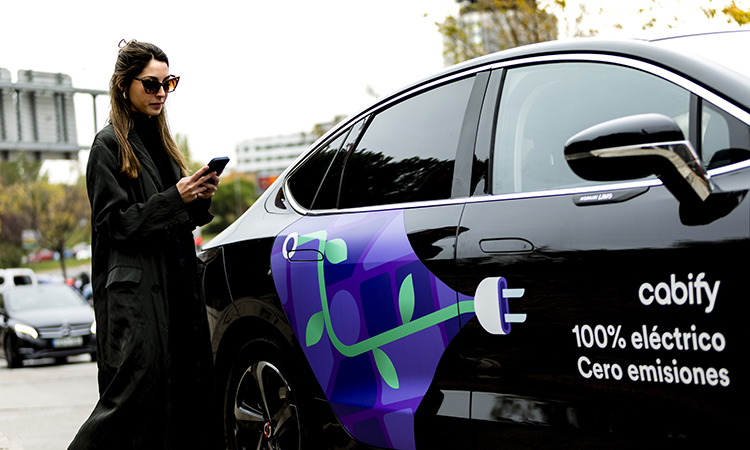Returning cities to their rightful owners
- Like
- Digg
- Del
- Tumblr
- VKontakte
- Buffer
- Love This
- Odnoklassniki
- Meneame
- Blogger
- Amazon
- Yahoo Mail
- Gmail
- AOL
- Newsvine
- HackerNews
- Evernote
- MySpace
- Mail.ru
- Viadeo
- Line
- Comments
- Yummly
- SMS
- Viber
- Telegram
- Subscribe
- Skype
- Facebook Messenger
- Kakao
- LiveJournal
- Yammer
- Edgar
- Fintel
- Mix
- Instapaper
- Copy Link
Posted: 28 March 2023 | David Pérez - Cabify | No comments yet
David Pérez, Senior Vice President of Stakeholder Relations at Cabify, discusses the challenges that often accompany the transition to renewable fuels, such as hydrogen and electric, and explains why it is important to offer and encourage mobility alternatives to the private car in order to achieve sustainable transport networks in cities.


Credit: Cabify
Not as many sectors face as big of a challenge nowadays as the transportation industry, particularly in terms of regulation, decarbonisation, technology, accessibility, security and, finally, how people want to move around cities. Not that long ago, a study1 investigating the attitudes towards public transport and smart mobility in eight of the biggest capitals around the globe found that 75% of people would choose a better connected public transport system, rather than driving. But is that really a possibility?
We are so used to how cities have evolved that we do not notice that they are no longer designed for people”
We are so used to how cities have evolved that we do not notice that they are no longer designed for people. They have become structured for cars – there are now more and more private cars and less space for people. This is something that is surprising if we take into consideration the fact that these cars spend 95% of their time parked on streets or in parking lots without being used, stealing, for example, walking space for pavements while occupying an area that could be used, for instance, for parks.
“Buy a home and get a car,” I still remember how those two things determined if someone’s life was going well. Having a private car in a city today is, even sometimes, counterproductive considering the time that we spend driving the vehicle in a city jammed by other cars, the time that we waste trying to park it, the money that we have to invest in maintenance, gas, parking etc. All of that, plus the pollution that we generate when using our cars.
Quantifying the impact of cars on people and places
According to INRIX2, London, to highlight one of the cities, has an average of 156 hours of traffic a year, and it costs each private car owner an estimated £1,377 annually. In another study of theirs3, they found that reducing excessive delay has a direct and immediate benefit of reducing carbon emissions from unnecessary idling at intersections. INRIX calculated that each single second of delay reduced across signals in the U.S. would translate into 800,000 fewer metric tonnes of CO2 that is emitted annually.
More cars mean more traffic jams, more pollution in cities and worse mobility for people. Billions of tonnes of CO2 is released into the atmosphere every year as a result of human activity. In fact, in 2021, a new record was set, and we closed the year with 36.3 billion tonnes of CO2 pollutant gases, according to the latest report from the International Energy Agency (IEA).
Encouraging modal shift
Step by step, we are all creating a mobility ecosystem that puts people at the centre of all decisions”
Slowly but consistently, we have been able to spread this message, and people are starting to consider all of the alternatives that cities now offer, like public transportation, micro-mobility, car-sharing, ride-hailing or taxis, to mention some. These options are less damaging to the environment and give people a chance to leave their cars behind and move freely through the city.
Step by step, we are all creating a mobility ecosystem that puts people at the centre of all decisions. More sustainable alternatives that return cities to their rightful owners: again, those who live in them.
The priority must be to reduce the use of private cars within cities, improve air quality and the health of the people living there”
The mobility of the future will be sustainable and, if it is not, there will be no mobility and no future. We just need to look at where all of the mobility companies are heading, how user awareness is growing and where regulations at different levels are also going. The priority must be to reduce the use of private cars within cities, improve air quality and the health of the people living there. Secondly, we need to focus on sustainable options for those mobility alternatives to have a more significant impact.
Technology as the catalyst to make cities better for the people that live in them
Sustainability is not just about emissions. We must continue to improve the efficiency of the resources at our disposal, and technology makes it possible to do so. Thanks to technology, sharing has become an ideal alternative for making more and better use of the resources that we have. For example, when a car is finishing a service, Cabify is already looking for the nearest ride to limit the time that the car moves around the city empty.
While technology helps us to make transportation more efficient and suited for everyone’s needs, there is still a lot to consider from a mobility company perspective. It is not only about how we can make our fleets more efficient through technology or offer different mobility options. It is important to also see how we can take advantage of the developments that are taking place in the industry.
It is exciting to see how solar cars are being developed and how companies are starting to experiment with autonomous driving. However, all of this is still a bit far away from becoming something feasible in terms of mobility in cities. On the other hand, there are technologies and solutions that are easier to access and that are already at our disposal. We have alternatives to fossil fuels that we did not have five to 10 years ago. In addition, electric vehicles (EVs) are evolving at a fast pace. The same goes for hydrogen-fuelled vehicles. At Cabify, we are currently using both alternatives to help the transportation sector to achieve the decarbonisation goal that the United Nations (UN) has set.
Cabify was born to offer a mobility alternative to the excess of private cars that invade the city. Working to achieve that, we have always strived to lead the sector in terms of sustainability. We were the first app in our industry, internationally, to offset 100% of our carbon footprint. Going even further, we have set an ambitious goal that 100% of trips on our platform will be in decarbonised or made by electric fleets by 2025 in Spain and 2030 in Latin America. To achieve this, we have received a €40 million loan to decarbonise our fleet of vehicles in Spain by increasing the availability of new EVs and charging infrastructure across the country.
While we work towards this, we will continue to offset our emissions, as we have done since 2018. We have offset more than 375,000 tonnes of CO2 by investing in forest conservation or renewable energy projects in the countries that we operate in.
The challenges ahead are not small but are achievable if we work together
Most nations have set a deadline for the decarbonisation of transport to become a reality, so any policy or business strategy that does not go towards this goal is simply set to the wrong destination. We must all commit to that goal now, on every level. It is a great moment to be in the transportation industry, as we can contribute to the long-needed change and build the mobility of the future.
Most nations have set a deadline for the decarbonisation of transport to become a reality, so any policy or business strategy that does not go towards this goal is simply set to the wrong destination”
Having said that, this comes with challenges. For example, there is still very limited availability of electric cars on the market. According to the European Environment Agency, only 18% of all new car registrations in the European Union (EU) were EVs in 2021. In addition, we also need to consider that, for a service like ours, not all EVs have the specificities required for ride-hailing activity, that there are not enough charging points in cities and those that do exist are not well located.
On the other hand, for private users, the prices of electric vehicles are still high compared to conventional gas-fuelled cars, which will continue to make the transition to electric vehicles slow.
It would not be fair to say all this without mentioning that there are already projects and things in motion. For example, the ‘Fit for 55’ package – a set of proposals that revises and updates EU legislation in order to put in place new initiatives with the aim of ensuring that EU policies are in line with the climate goals that have been agreed – already takes some of these challenges into consideration. For example, the minimum mandatory national targets for the deployment of alternative fuels infrastructure have been set. Therefore, electric charging pools for cars would have to be deployed at least every 60km along main EU roads by 2026.
This is the moment for companies, citizens and governments to come together and work towards the mobility of the future, which, as I mentioned, will be sustainable. If it is not, there will be no mobility and no future. The sooner that we realise this, the faster we can give back cities to those it belongs to, pulling unnecessary cars off of the streets and helping the planet while doing so.
References
- https://www.globenewswire.com/news-release/2023/01/25/2594837/0/en/Three-in-four-people-prefer-better-connected-public-transport-over-driving-new-global-study-reveals.html
- https://inrix.com/press-releases/2022-global-traffic-scorecard-uk/
- https://inrix.com/press-releases/agencies-in-20-states-now-use-inrix-signal-analytics/


Related topics
Alternative Power, Fleet Management & Maintenance, Mobility Services, Modal shift, On-Demand Transport, Passenger Experience, Sustainable Urban Transport, Traffic Management
Issue
Issue 1 2023
Related modes
Ride-sharing & Car-sharing
Related countries
Spain
Related organisations
Cabify
Related people
David Pérez








